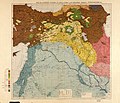Fertile Crescent
Fertile Crescent
The Fertile Crescent is a region in the Middle East which curves, like a quarter-moon shape, from the Persian Gulf, through modern-day southern Iraq, Syria, Lebanon, Jordan, Israel and northern Egypt. The region has been recognized for its fertile soil and important role in the development of ancient civilizations.
Geography[edit]
The Fertile Crescent covers modern-day Iraq, Syria, Lebanon, Jordan, Israel, and northern Egypt. It is a region where the soil is fertile due to the regular flooding of rivers such as the Tigris and Euphrates in Iraq. The shape of the region is like a crescent or a quarter-moon.
History[edit]
The Fertile Crescent is often called the Cradle of Civilization, as it was here that the first advanced civilizations developed. The first known human civilizations appeared in the Fertile Crescent after the last Ice Age. The civilizations that emerged in this region, including the Sumerians, Akkadians, Babylonians, Assyrians, and Phoenicians, made significant contributions to human development and progress.
Agriculture[edit]
The Fertile Crescent is known for its fertile soil, which is ideal for agriculture. The region is believed to be the place where agriculture first developed during the Neolithic Revolution. The abundance of water and the fertility of the soil allowed for the growth of surplus crops, which led to the development of complex human societies.
Significance[edit]
The Fertile Crescent is significant for its contributions to human civilization. The region is home to the first known human civilizations, and it is where writing, the wheel, agriculture, and the first cities were developed.
See also[edit]
References[edit]
<references />
|
|
|
-
Fertile Crescent
-
Quarta Asie tabula
-
Fertile Crescent concept 1916
-
Fertile crescent Neolithic B circa 7500 BC
-
Maunsell's map, Pre-World War I British Ethnographical Map of eastern Turkey in Asia, Syria and western Persia
-
Diffusion of agriculture from the Fertile Crescent after 9000 BC
Ad. Transform your life with W8MD's Budget GLP-1 injections from $75


W8MD offers a medical weight loss program to lose weight in Philadelphia. Our physician-supervised medical weight loss provides:
- Weight loss injections in NYC (generic and brand names):
- Zepbound / Mounjaro, Wegovy / Ozempic, Saxenda
- Most insurances accepted or discounted self-pay rates. We will obtain insurance prior authorizations if needed.
- Generic GLP1 weight loss injections from $75 for the starting dose.
- Also offer prescription weight loss medications including Phentermine, Qsymia, Diethylpropion, Contrave etc.
NYC weight loss doctor appointmentsNYC weight loss doctor appointments
Start your NYC weight loss journey today at our NYC medical weight loss and Philadelphia medical weight loss clinics.
- Call 718-946-5500 to lose weight in NYC or for medical weight loss in Philadelphia 215-676-2334.
- Tags:NYC medical weight loss, Philadelphia lose weight Zepbound NYC, Budget GLP1 weight loss injections, Wegovy Philadelphia, Wegovy NYC, Philadelphia medical weight loss, Brookly weight loss and Wegovy NYC
|
WikiMD's Wellness Encyclopedia |
| Let Food Be Thy Medicine Medicine Thy Food - Hippocrates |
Medical Disclaimer: WikiMD is not a substitute for professional medical advice. The information on WikiMD is provided as an information resource only, may be incorrect, outdated or misleading, and is not to be used or relied on for any diagnostic or treatment purposes. Please consult your health care provider before making any healthcare decisions or for guidance about a specific medical condition. WikiMD expressly disclaims responsibility, and shall have no liability, for any damages, loss, injury, or liability whatsoever suffered as a result of your reliance on the information contained in this site. By visiting this site you agree to the foregoing terms and conditions, which may from time to time be changed or supplemented by WikiMD. If you do not agree to the foregoing terms and conditions, you should not enter or use this site. See full disclaimer.
Credits:Most images are courtesy of Wikimedia commons, and templates, categories Wikipedia, licensed under CC BY SA or similar.
Translate this page: - East Asian
中文,
日本,
한국어,
South Asian
हिन्दी,
தமிழ்,
తెలుగు,
Urdu,
ಕನ್ನಡ,
Southeast Asian
Indonesian,
Vietnamese,
Thai,
မြန်မာဘာသာ,
বাংলা
European
español,
Deutsch,
français,
Greek,
português do Brasil,
polski,
română,
русский,
Nederlands,
norsk,
svenska,
suomi,
Italian
Middle Eastern & African
عربى,
Turkish,
Persian,
Hebrew,
Afrikaans,
isiZulu,
Kiswahili,
Other
Bulgarian,
Hungarian,
Czech,
Swedish,
മലയാളം,
मराठी,
ਪੰਜਾਬੀ,
ગુજરાતી,
Portuguese,
Ukrainian








